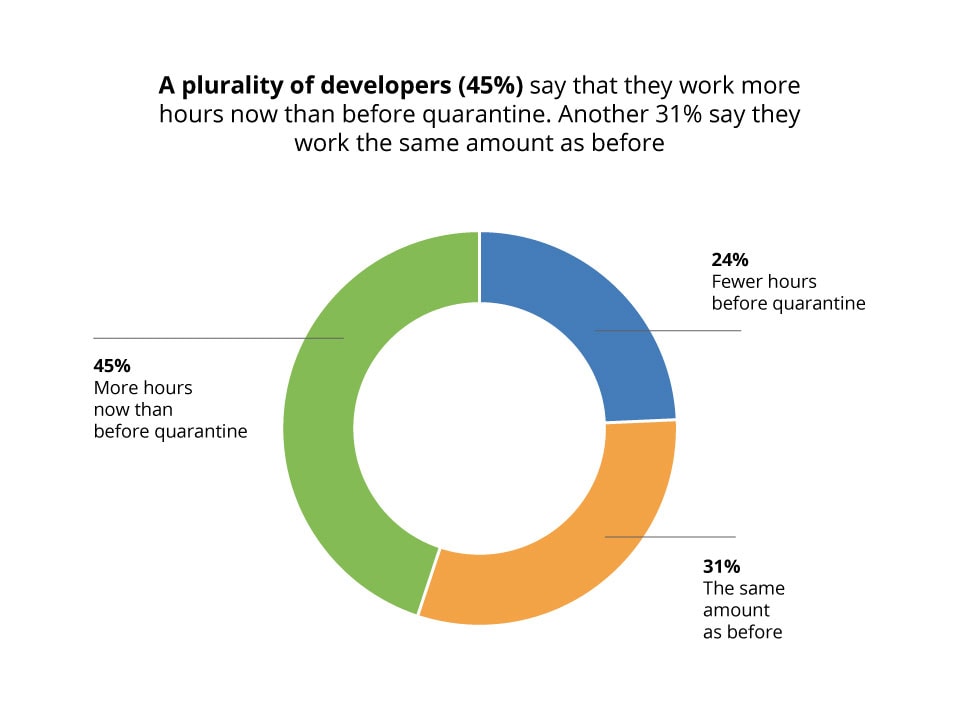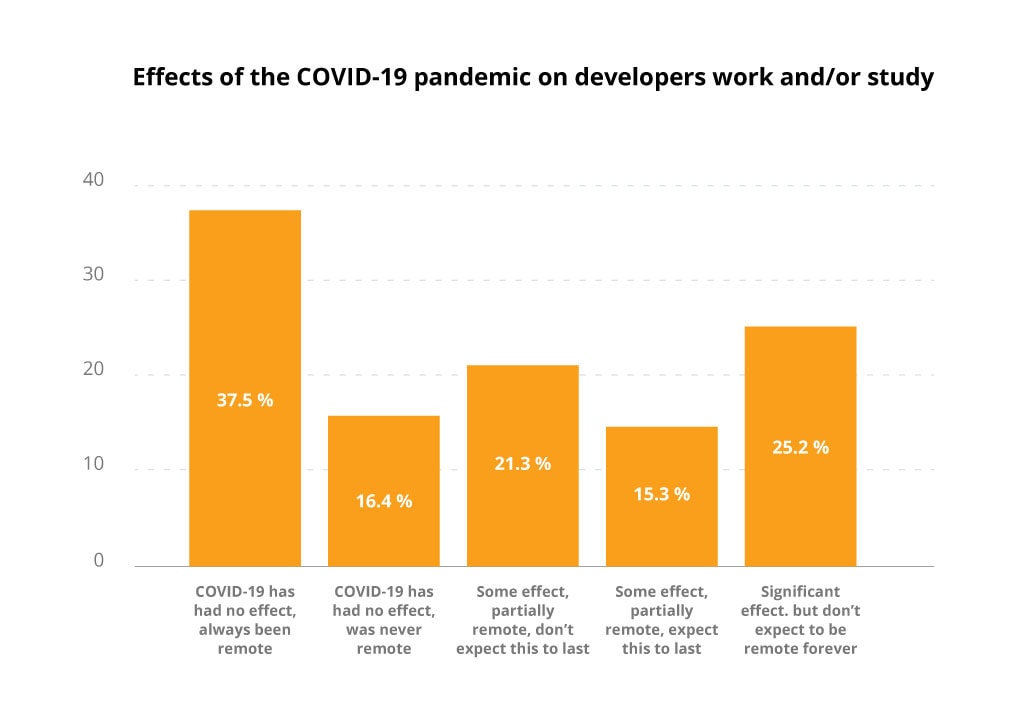
How many software developers are there in the world?
Software is the driving force of the world today – with an estimated 9 trillion devices in active use, it is the glue that connects people from all corners of the globe. Software developers are shaping and building the modern technological world.
Hotspots for growth (in terms of developers) are constantly changing as the number of software developers worldwide continues to increase. Based on these predictions and recent developer growth rates since then, we already know how things look today.
How many software engineers are there in the world?
According to the 20th edition of the State of the Developer Nation report, there were 26.8 million active software developers in the world at the end of 2021. Experts predict that the number of global software engineers will grow to reach 45 million by 2030. These are very impressive figures that prove that the demand for IT professionals is growing – and will continue to grow – all around the world.
According to Evans Data Corporation, in 2022 there were 26.3 million software developers worldwide, a 3.1% increase compared to 2021. The company anticipates this growth will continue, with global tech headcount expected to hit 29.3 million by 2027.
How many software engineers are in the United States?
The United States boasts over 4.4 million software engineers, ranking it as the world’s third-largest technology hub, following China and India.
The Developer Nation survey reveals that a predominant portion of the workforce in the software development sector, about 43%, identifies themselves as programmers or software developers. Other common positions include students of computer and data science, technology/engineering team leaders, software architects, developers specializing in machine learning, and data engineers.
Corresponding with these findings, DataUSA estimates the U.S. workforce in the software development field to be approximately 1.57 million people. The primary employment sector for these professionals is computer systems design, with a significant number also working in architectural, engineering, and related services.
How many software engineers are in Europe?
Europe’s software developer population is currently estimated to be around 6.1 million, with Germany leading in numbers, hosting slightly more than 1 million software engineers. France and the UK are also prominent, boasting 533,000 and 465,000 software developers, respectively, making them the second and third largest national populations of software developers in Europe.
However, as the demand for IT professionals continues to surge, many Western European countries are facing significant challenges in recruiting engineers locally. The European tech market is notably impacted by a deficit of approximately 500,000 software developers.
What does the global developer population growth mean for developers in Europe?
Will a significant increase in the number of developers in Asia and Latin America affect developers in countries like Poland? The likely answer is ‘no’. Developers in Poland have clients from all over Europe.
These connections are only expected to become stronger in the future, and the reasons behind this are:
- Poland has top-level developers in many programming languages and fields of technology
- Polish software specialists are ranked among the top 3 in terms of countries with the best developers:
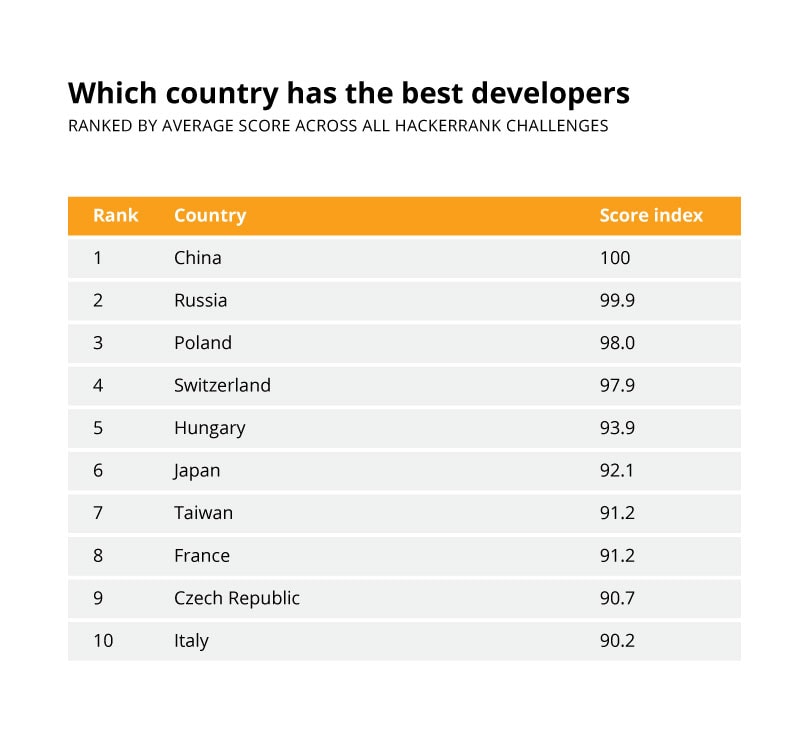
- Polish software companies offer an outstanding price-to-quality ratio
- Polish developers are known to keep working on a problem until a proper solution has been found, according to ‘Which Country Never Gives Up?’ research:

As long as developers in countries like Poland continue to put out quality products, organisations will have little to no incentive to outsource projects to developers in other countries, even if it may cost a little less.
Besides, developers from India and China have huge domestic populations of their own to serve, where they do not face potential challenges such as miscommunication due to language barriers and differences in time zones, etc.
You can create a Request for Proposal for your project and compare proposals among European and Asian IT companies. If you are looking for software development services see our case studies and the companies we work with.
Software engineers demographic
How are age demographics distributed among software developers?
According to the Stack Overflow Developer Survey, which is one of the largest and most comprehensive surveys of software developers globally, the majority of respondents tend to be younger, with a significant concentration in the 25-34 age group. This is reflective of the rapid growth of the tech industry and the constant influx of new entrants into the software development field.
The survey typically shows:
- A notable portion of developers are under 24, highlighting the early start many take in this career.
- The largest group often falls within the 25-34 age range, indicating a young workforce.
- There is a significant representation of developers in the 35-44 age range, showcasing experienced professionals who have grown with the industry.
- Developers over the age of 45 are less represented but still constitute a vital part of the community, bringing decades of experience.
It’s important to remember that these trends can shift slightly from year to year and may vary depending on the region, specific technology sectors (such as web development, mobile app development, systems programming, etc.), and the pace at which new people enter the field.
What is the current gender breakdown in the software development workforce?
There’s also been quite a noticeable (and positive) shift in the number of female developers. Historically, the tech sector, including software development, has been male-dominated, but efforts to balance gender representation have intensified in recent years.
According to various industry surveys and reports, including the Stack Overflow Developer Survey, in april 2023, women typically represent about 10% to 12% of the professional software development workforce globally. This figure can vary significantly by region, company, and specific tech sectors.
The number of women in tech is visibly growing, largely due to the increasing availability of various conferences, workshops, summits, university courses, and festivals that have been organised specifically for women.
And female software developer is generally younger than her male counterpart, so we can expect that this is only the beginning, and that the gender ratio in IT will soon become a lot more balanced.
What are most popular programming languages among software developers?
There are a few programming languages that we should pay attention to:
- JavaScript – this is the most common one, with nearly 16.5 million engineers using it globally;
- Python – with 11.3 million users, this is the second most popular language in the world, typically used in data science and machine learning;
- Java – an established programming language, it gained renewed popularity in the Android mobile app ecosystem, and is now used by well over 9 million developers;
- PHP – the second most widely adopted language for web apps (after JavaScript), with 7.3 million users globally;
- C# – this language has around 6.8 million users, and most of them use it for desktop apps, as well as for AR/VR and game development.
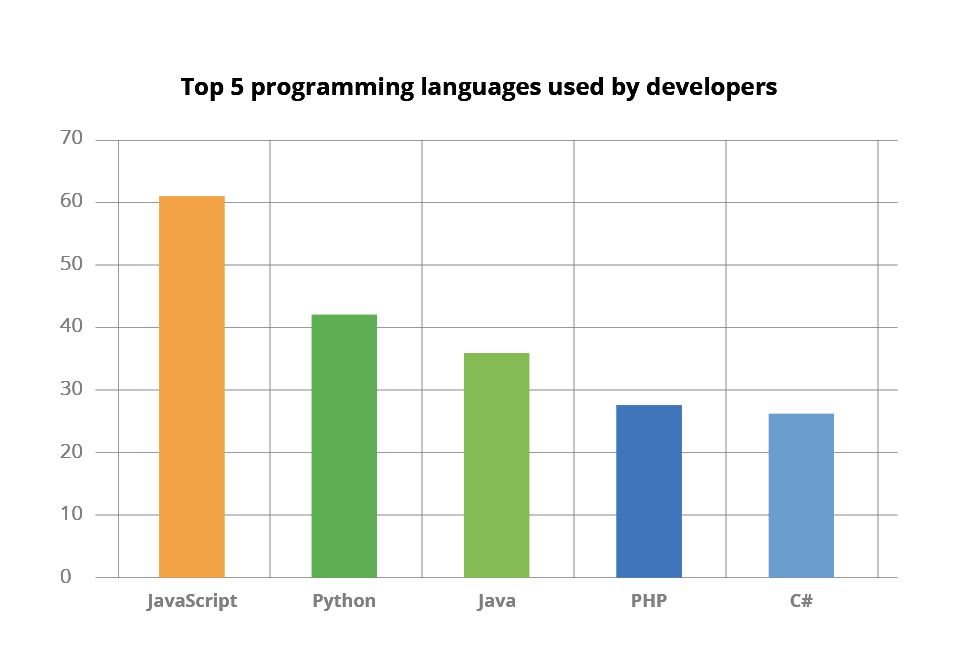
Of course, these languages are not only popular among software developers but also highly sought after by employers:
- JavaScript
- Python
- Java
- C#
- C++
- PHP
- Language Agnostic
- C
- Go
- Ruby
Read more articles about software development:
- 10 New Software Development Technologies and Trends
- How to create a proof of concept in software development?
- Software architecture in software engineering: types, challenges and best practices
- Software engineer consultants – how can they help you succeed?
How many software developers in the world have university degrees?
General tendencies show that the bigger the company, the higher the degree of education it expects from its employees. Smaller companies are less likely to require even a Bachelor’s degree from developers, which creates huge employment opportunities for self-taught experts.
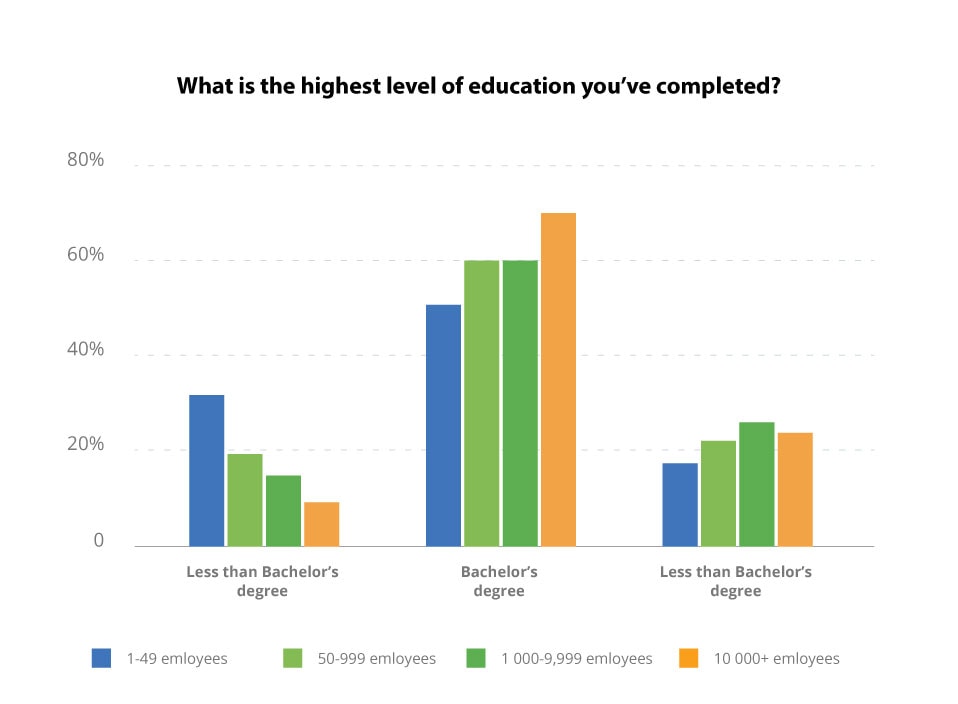
According to the Stack Overflow Developer Survey and other industry reports:
- A majority of software developers have obtained a degree related to computer science, software engineering, or a related field. The percentage can vary but is often reported to be over 50%.
- There is also a notable percentage of developers who have degrees in fields unrelated to computer science or software engineering, reflecting the diverse paths people take to enter the software development profession.
- Additionally, the tech industry has seen a rise in developers who are self-taught or have completed coding bootcamps, online courses, or other non-traditional forms of education to gain the necessary skills.
Newer generations of developers are also utilising different sources of knowledge, such as YouTube videos or coding bootcamps, while older generations – with baby boomers leading the way – prefer to learn how to code from books and on-the-job training.
Emerging technologies in IT industry
Just as technologies constantly evolve, so do popular areas of interest within software development. Developers are increasingly becoming more engaged with (% of developers using, learning about, or interested in each technology):
- Artificial Intelligence (AI) and Machine Learning (ML) – AI and ML are increasingly integrated into software development processes, automating tasks like code generation, testing, and even bug fixes. AI-augmented software development is enhancing productivity and enabling more sophisticated software solutions.
- robotics – the design and construction of robots that can mimic human behaviour and assist humans in different activities with great precision.
- computer vision – the analysis of digital images and videos for valuable data extraction.
- cryptocurrencies – where data can be used as a medium of exchange or, in other words, as digital money or virtual currency.
- blockchain technology: Beyond cryptocurrencies, blockchain offers a new paradigm for secure and decentralized applications (DApps), smart contracts, and enhanced data security practices. Its applications are expanding into finance, supply chain management, and secure transactions.
- Cloud computing – revolutionizing the way businesses store and access data, cloud computing enables scalable, flexible, and efficient computing resources over the internet. The evolution of cloud computing includes developments in serverless architectures, cloud-native technologies, and hybrid cloud solutions, allowing for more agile and cost-effective cloud-based software development.
- Low-code/No-code development – these platforms enable rapid application development with minimal hand-coding, opening up software development to non-technical users and accelerating the development process for experienced developers.
Find out more about how to use these technologies in your business:
- The pros and cons of using GitHub Copilot for software development – survey results
- Things Artificial Intelligence can do for your business
- Machine Learning strategy for businesses: a practical guide
- How to implement cloud computing?
However, despite the increasing academic interest in these fields, the actual adoption rates of these technologies are significantly lower. Only 10-15% of the developers interested in these topics are currently working on related projects.
And when it comes to specific programming languages that developers are willing to learn, Go – a simple and efficient open-source language designed in Google – remains at the helm:

Python and Kotlin follow at a close second and third. This can only mean that interest in big data, machine learning and Android apps will not be slowing down anytime soon.
The supply and demand of software developers
While the current supply of developers seems to be very high, the need for their services shows no signs of slowing down. With thousands of start-ups popping up in various countries each year, the demand for developers is, in fact, soaring.
Some reasons as to why this may include:
- Multiple versions of the same things are needed – as with any other industry, people tend to keep making the same things over and over again. This is because different regions need different versions of the same applications for local use.
- The code has a limited lifetime – it might appear as if once an application has been built, the work is finished. In reality, though, most of the time, the code is constantly being altered – and most companies are always looking to hire new talent.
- Projects are growing in complexity – the complexity and scalability of many projects are increasing every day, especially as the software industry continues to tackle more complex problems – which is exactly why highly skilled and talented developers are in constant demand.
- The number of coding languages being used is constantly growing, as is the number of software developers.
The influence of the pandemic
The COVID-19 pandemic has affected many industries, creating a strong demand for dedicated solutions and customised systems. Almost a third of all companies – including 80% of IT companies worldwide – have switched to working remotely.
Some early research on this issue by Coderbite, brings attention to the problem of working overtime, as the new solutions are needed right now, no matter how many hours it takes to deliver them.
Also, leading a team that works remotely for a long time is a challenge. Especially if it is a new situation for some of the team members. Fortunately, there are a lot of online solutions and tools available to help you keep the work efficiency and team spirit on the highest level, no matter if you are working from the office or from home.
We highly recommend that you familiarise yourself with our tips on managing remote teams successfully. Especially now that we know that we will need to deal with the ups and downs of the pandemic for many years to come. This has had a significant influence on the way that developers work:
What’s next?
Over the last three decades, the computer software industry has been experiencing high growth rates.
Subsequently, this sector has become one of the most internationally dispersed in the world. As a result, the industry continues to provide unique and unparalleled opportunities that support the broader development and growth of many developing countries.
With the mutually increasing supply and demand of developers worldwide, the software domain is sure to continue growing into a very dynamic global industry. This gives us hope that we will also see a corresponding increase in the percentage of female developers around the world.
From the perspective of software development, the future looks very promising. And if you need an experienced software development partner – give us a call!

